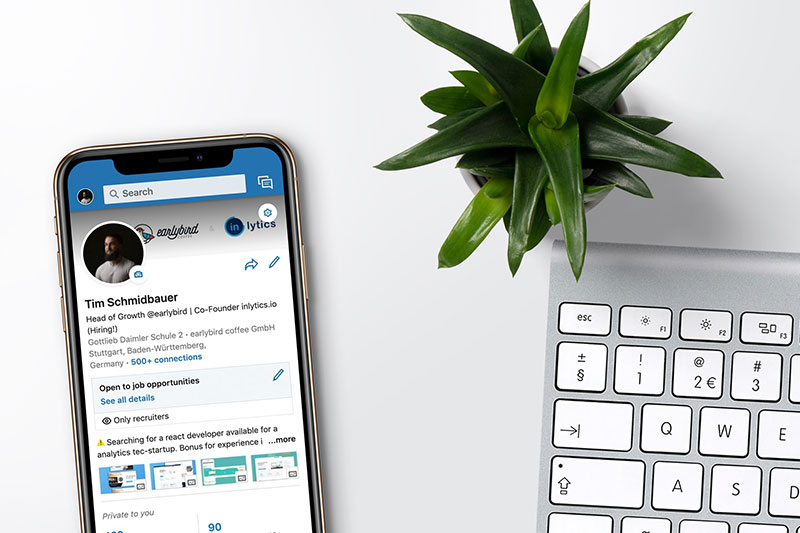Best known for its extensive B2B network, LinkedIn is surprisingly helpful for helping you get a leg up in your lead generation pipeline – especially if you target your audience right.
What is Lead Generation?
Lead generation is the process of attracting leads (potential customers) and converting them into sales prospects using a combination of inbound and outbound marketing strategies.
Is LinkedIn Good For Lead Generation?
With more than 706 million users in more than 200 countries and territories worldwide (40% of whom access it on a daily basis), LinkedIn is by far the world’s largest professional network. It’s commonly regarded to be a B2B goldmine, with a whopping 80% of B2B leads said to come through LinkedIn (making it 277% more effective than Facebook when it comes to generating leads).
A wholly-owned subsidiary of Microsoft since 2016, the platform is particularly popular amongst senior-level influencers with high-purchasing power and is the most-used social media platform amongst Fortune 500 companies.
Given all the above, it’s no surprise that so many entrepreneurs, salespeople, freelancers, and executives turn to LinkedIn as their first choice for lead generation. But, if we were to hazard a guess, we’d go ahead and assume that LinkedIn is probably the most under-utilised weapon currently in your marketing armoury.
So, instead of leaving money on the table, these tried-and-tested tips on using LinkedIn for lead generation will help you leverage the tools you have at your disposal to secure promising more leads.

How Do You Generate Leads on LinkedIn?
1. Optimise Your Professional Profile for Engagement
This step is crucial. The very first thing anyone does on LinkedIn after receiving a connection request is to check out that person’s profile. Remember to:
• Use a high-quality, well-lit professional picture for your profile photo
• Add a (suitable) background profile to grab people’s attention
• Improve your headline so that it’s more than just a job title (be sure to include valuable keywords)
• Customise your URL to help people easily find your profile
• Inject some personality into your “About” summary
• Emphasise your professional skills using specific keywords
• Make sure that every section has been completed (industry, location, education, current and most recent employment history, etc.)
• Update your contact information
• Get endorsements and recommendations from colleagues, managers, or clients
• Add projects and links
• Grow your connections on LinkedIn (no one wants to have fewer than 500 LinkedIn connections…)
• Develop healthy inbound links to your profile to help you appear higher in search results
2. Leverage LinkedIn’s Lead Generation Ads
Taking advantage of LinkedIn’s easy-to-use Lead Gen Forms is one of the best ways to bolster your lead generation capabilities. Available as a sponsored ad or message, LinkedIn’s lead generation ads help users pre-fill a form with their profile data – anything from sign-up forms to a booking inquiry, allowing them to submit a request with just one simple click. This saves time and effort on the part of your potential leads, drastically reducing the chances of them clicking away.
Australian performance management software company IR conducted a case study on their usage of Lead Gen Forms alongside Sponsored Content and discovered that they were able to achieve a 2x increase in conversion rates with their target audience, and also managed to reduce their cost per lead by 44%.

3. Use LinkedIn’s InMail to Connect with Your Contacts
Did you know that the InMail response rate is 3x that of traditional email? Unlike traditional email, which is getting increasingly difficult to gain visibility on, InMail messages tend to be more targeted and credible, as the recipient can easily check the sender’s LinkedIn profile for additional information.
Now, if you want to drive sales or higher response rates, you’re going to have to warm up your cold outreach. Here’s how:
• Connect with your prospect first. Keeping your message short and succinct, explain how you came to find them and your reason for reaching out. Don’t try and “sell” anything to them right off the bat. At this stage, you’re just trying to forge a connection and build trust.
• Avoid sending a generic copied-and-pasted message as these will be ill-received, and LinkedIn may even flag your account.
• Instead, make your message personal by drawing on information found on their profile and connecting on some common ground. Personalising your outreach will make your message seem a lot more authentic and less sales-y, improving your odds of success.
• Think of email outreach as being a value exchange. When they reply, thank them for accepting your request and try to offer them something of value. For example, you can offer to connect them with your network or even share a free resource with them.
• Only ask for a favour once you’ve already established a firm relationship with them. This can take some time.
• When it does come time to get to your “ask”, be clear as to what exactly it is that you’ve got to offer them and how you can add value to their business.
• Before sending, don’t forget to add a call-to-action to trigger the right action. Never leave a message open-ended. It’s up to you to lead the conversation and keep your message on track.
• Finally, no matter how insignificant a message may seem to be, always follow-up and thank them for taking the time to reply.
4. Join LinkedIn Groups & Post Relevant Content
By freely sharing your knowledge in groups relevant to your niche, you’ll slowly begin to establish yourself as an expert in your field whilst simultaneously building relationships with members, members who, over time, may turn into customers. Before posting in any group, be sure to familiarise yourself with the Group Rules, as these rules tend to vary from group to group.
Only post content that is relevant to your niche and provides value to your audience. Keep your messaging less sales-y, and more helpful, as being overly promotional can be a serious turn off to others and may even get you banned. Here are some tips for finding the best LinkedIn groups to join.
Want to take it one step further? Consider creating your own LinkedIn group.

5. Answer Targeted Questions to Establish Your Expertise
Within your relevant groups, you’ll often find individuals posing various questions related to your field. This is yet another opportunity for you to forge genuine connections by being helpful. Jump in, join in on the discussions, and add value by sharing your expertise and knowledge. The key here is to help people before you start plugging your business or latest product.
6. Publish Authoritative Industry-Focused Articles
By publishing educational articles and blog posts about industry news and topics, you not only position yourself and your brand as an authority in your space, but you also have the potential to drive traffic to your site. If someone replies to your article with a query, be sure to reply with a solution to their problem. Over time, you’ll establish yourself as an industry leader, warming them up for when you eventually want to ask them for a favour.
On top of publishing articles, you should also comment and react to posts on a regular basis in order to boost your profile’s visibility. It’s recommended that you post during work hours, particularly in the morning or early afternoon.
7. Stay Active on LinkedIn with Regular Posts
Again, avoid being too sales-y here. Instead, add value by sharing your expertise and insights. Aim to post at least three times a week and no more than once a day. Any more, and engagement is likely to drop.
8. Personalise your Outreach Using LinkedIn’s Dynamic Ads
Dynamic ads are personalised ads tailored to each recipient based on their own LinkedIn profile data, such as profile photo, company name, or job title. By placing a custom tag (e.g. your recipient’s first name) within one of your outreach ads, you’ll be able to spark a stronger connection with each individual, making it more likely that they’ll take an interest in your ad.

Dynamic Ads have such an elevated level of personalisation that they’ve been proven to significantly improve click-through-rates and are a fantastic way to accumulate new quality leads. While they can be costly, the results speak for themselves.
9. Turn Your Profile Views into New Business
Depending on your privacy settings, you may have visibility on who has recently visited your profile. This is a great (and often overlooked) opportunity to generate leads. So next time you receive that oh-so-familiar notification, “Someone has viewed your profile”, instead of ignoring it, reach out to the individual, invite them to connect, and get to the bottom as to why they visited your profile in the first place. Given that they’ve already shown enough interest in you to click on your page, there’s a possibility that they may very well already be interested in one of your products or services. In any case, warm leads are always better than cold leads.
10. Use LinkedIn’s Sales Navigator Service
Target the right people and companies using LinkedIn’s very own Sales Solutions platform. According to LinkedIn, users have reported +18% more pipeline, +7% higher win-rate, and +33% larger deal sizes since using their Sales Navigator. Designed for sales professionals, LinkedIn’s Sales Solutions not only helps you find prospects faster, but it also offers a whole host of training resources and materials to help you build up your skills and close more deals.
Wrapping Up
Finally (and most importantly!) be sure to stay active. This will ensure that you stay at the forefront of your network’s social feed. One post a week should suffice.
So there you have it. 10 Linkedin lead generation strategies that actually work. LinkedIn is one of the more overlooked and underutilised social marketing tools available today. But, with a little time and effort, you too can generate high-quality leads at scale.
Related Articles
5 Strategies to Build a Successful Sales Enablement Approach





